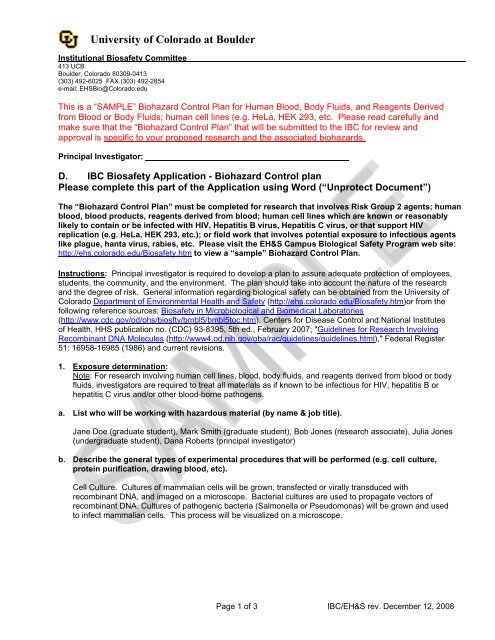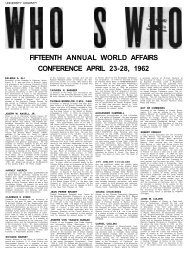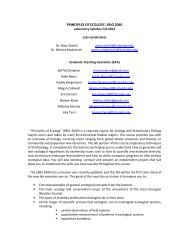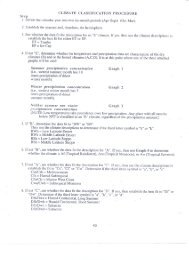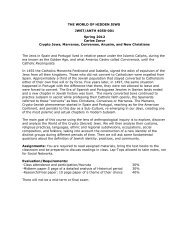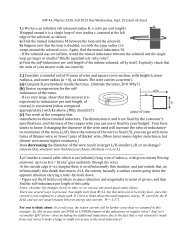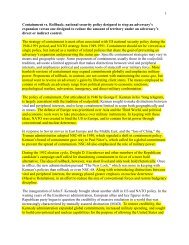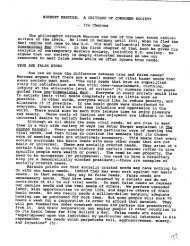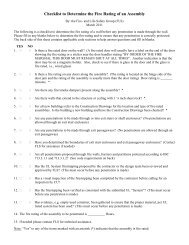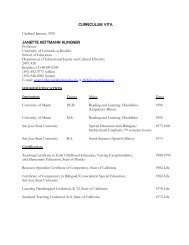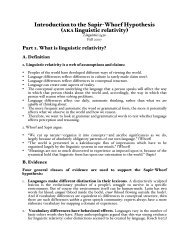Biohazard Control Plan for RG 2 or BBP Agents - University of ...
Biohazard Control Plan for RG 2 or BBP Agents - University of ...
Biohazard Control Plan for RG 2 or BBP Agents - University of ...
You also want an ePaper? Increase the reach of your titles
YUMPU automatically turns print PDFs into web optimized ePapers that Google loves.
<strong>University</strong> <strong>of</strong> Col<strong>or</strong>ado at Boulder<br />
Institutional Biosafety Committee<br />
413 UCB<br />
Boulder, Col<strong>or</strong>ado 80309-0413<br />
(303) 492-6025 FAX (303) 492-2854<br />
e-mail: EHSBio@Col<strong>or</strong>ado.edu<br />
This is a “SAMPLE” <strong>Biohazard</strong> <strong>Control</strong> <strong>Plan</strong> <strong>f<strong>or</strong></strong> Human Blood, Body Fluids, and Reagents Derived<br />
from Blood <strong>or</strong> Body Fluids; human cell lines (e.g. HeLa, HEK 293, etc. Please read carefully and<br />
make sure that the “<strong>Biohazard</strong> <strong>Control</strong> <strong>Plan</strong>” that will be submitted to the IBC <strong>f<strong>or</strong></strong> review and<br />
approval is specific to your proposed research and the associated biohazards.<br />
Principal Investigat<strong>or</strong>:<br />
D. IBC Biosafety Application - <strong>Biohazard</strong> <strong>Control</strong> plan<br />
Please complete this part <strong>of</strong> the Application using W<strong>or</strong>d (“Unprotect Document”)<br />
The “<strong>Biohazard</strong> <strong>Control</strong> <strong>Plan</strong>” must be completed <strong>f<strong>or</strong></strong> research that involves Risk Group 2 agents; human<br />
blood, blood products, reagents derived from blood; human cell lines which are known <strong>or</strong> reasonably<br />
likely to contain <strong>or</strong> be infected with HIV, Hepatitis B virus, Hepatitis C virus, <strong>or</strong> that supp<strong>or</strong>t HIV<br />
replication (e.g. HeLa, HEK 293, etc.); <strong>or</strong> field w<strong>or</strong>k that involves potential exposure to infectious agents<br />
like plague, hanta virus, rabies, etc. Please visit the EH&S Campus Biological Safety Program web site:<br />
http://ehs.col<strong>or</strong>ado.edu/Biosafety.htm to view a “sample” <strong>Biohazard</strong> <strong>Control</strong> <strong>Plan</strong>.<br />
Instructions: Principal investigat<strong>or</strong> is required to develop a plan to assure adequate protection <strong>of</strong> employees,<br />
students, the community, and the environment. The plan should take into account the nature <strong>of</strong> the research<br />
and the degree <strong>of</strong> risk. General in<strong>f<strong>or</strong></strong>mation regarding biological safety can be obtained from the <strong>University</strong> <strong>of</strong><br />
Col<strong>or</strong>ado Department <strong>of</strong> Environmental Health and Safety (http://ehs.col<strong>or</strong>ado.edu/Biosafety.htm)<strong>or</strong> from the<br />
following reference sources: Biosafety in Microbiological and Biomedical Lab<strong>or</strong>at<strong>or</strong>ies<br />
(http://www.cdc.gov/od/ohs/biosfty/bmbl5/bmbl5toc.htm), Centers <strong>f<strong>or</strong></strong> Disease <strong>Control</strong> and National Institutes<br />
<strong>of</strong> Health, HHS publication no. (CDC) 93-8395, 5th ed., February 2007; "Guidelines <strong>f<strong>or</strong></strong> Research Involving<br />
Recombinant DNA Molecules (http://www4.od.nih.gov/oba/rac/guidelines/guidelines.html)," Federal Register<br />
51: 16958-16985 (1986) and current revisions.<br />
1. Exposure determination:<br />
Note: F<strong>or</strong> research involving human cell lines, blood, body fluids, and reagents derived from blood <strong>or</strong> body<br />
fluids, investigat<strong>or</strong>s are required to treat all materials as if known to be infectious <strong>f<strong>or</strong></strong> HIV, hepatitis B <strong>or</strong><br />
hepatitis C virus and/<strong>or</strong> other blood-b<strong>or</strong>ne pathogens.<br />
a. List who will be w<strong>or</strong>king with hazardous material (by name & job title).<br />
Jane Doe (graduate student), Mark Smith (graduate student), Bob Jones (research associate), Julia Jones<br />
(undergraduate student), Dana Roberts (principal investigat<strong>or</strong>)<br />
b. Describe the general types <strong>of</strong> experimental procedures that will be per<strong>f<strong>or</strong></strong>med (e.g. cell culture,<br />
protein purification, drawing blood, etc).<br />
Cell Culture. Cultures <strong>of</strong> mammalian cells will be grown, transfected <strong>or</strong> virally transduced with<br />
recombinant DNA, and imaged on a microscope. Bacterial cultures are used to propagate vect<strong>or</strong>s <strong>of</strong><br />
recombinant DNA. Cultures <strong>of</strong> pathogenic bacteria (Salmonella <strong>or</strong> Pseudomonas) will be grown and used<br />
to infect mammalian cells. This process will be visualized on a microscope.<br />
Page 1 <strong>of</strong> 3 IBC/EH&S rev. December 12, 2008
<strong>University</strong> <strong>of</strong> Col<strong>or</strong>ado at Boulder<br />
Institutional Biosafety Committee<br />
413 UCB<br />
Boulder, Col<strong>or</strong>ado 80309-0413<br />
(303) 492-6025 FAX (303) 492-2854<br />
e-mail: EHSBio@Col<strong>or</strong>ado.edu<br />
2. <strong>Control</strong> methods:<br />
a. Describe facility in which w<strong>or</strong>k is to be per<strong>f<strong>or</strong></strong>med.<br />
Mammalian cell culturing and viral transduction will be done in either the Tissue Culture Facility (Cristol<br />
214) <strong>or</strong> in Cristol 250 in a BSL2 Biosafety Cabinet. Bacterial culturing (E. Coli, non biohazardous) will be<br />
done in Cristol 328. Culturing <strong>of</strong> Salmonella will be done in room 328 in an area designated <strong>f<strong>or</strong></strong><br />
Salmonella BSL2 w<strong>or</strong>k. This area is marked with appropriate signs. Culturing <strong>of</strong> Pseudomonas will only<br />
be done in a BSL2 Biosafety Cabinet, either in Cristol 250 <strong>or</strong> in the lab<strong>or</strong>at<strong>or</strong>y (Benson 445) <strong>of</strong> Mary Smith<br />
(Co-PI on this project). All rooms are equipped with hand washing stations and eye washes.<br />
b. Describe who will have access to the facility and how access will be controlled (If relevant,<br />
describe signs, do<strong>or</strong>s, type <strong>of</strong> lock, separation from c<strong>or</strong>rid<strong>or</strong>s and other w<strong>or</strong>k areas, etc.)<br />
The labs will be locked and only personnel who have been properly trained (see question 7) will have<br />
keyed access. A hazard warning sign (w/ universal biosafety symbol) will be posted on the do<strong>or</strong> to the lab<br />
and again right at the BL2 w<strong>or</strong>k area. Any trash cans that contain BL2 waste will be clearly marked (again<br />
with universal symbol) so these are not changed by custodial personnel<br />
c. How and when will facility be cleaned and decontaminated? Will Facilities Management custodial<br />
personnel have routine access, and if so, how will they be protected from hazardous materials?<br />
Facility will be cleaned and decontaminated by lab<strong>or</strong>at<strong>or</strong>y personnel immediately after use. All waste will<br />
be disposed <strong>of</strong> properly. Any potentially contaminated surfaces will be cleaned with bleach and ethanol.<br />
Custodial personnel will have access to the rooms but all infectious waste will be handled by our lab and<br />
non-infectious waste will be sealed in puncture pro<strong>of</strong> containers.<br />
d. Describe safety devices that will be used. These may include some <strong>or</strong> all <strong>of</strong> the following:<br />
biosafety cabinets, hand washing facilities, mechanical pipetting devices, puncture resistant<br />
sharps containers, splash guards, self-sheathing needles.<br />
Biosafety cabinet-level II, eye-wash and hand-wash stations, autoclave <strong>f<strong>or</strong></strong> decontaminating waste, clearly<br />
labeled BSL2 waste containers, clearly labeled puncture-pro<strong>of</strong> sharps containers, mechanical pipeting<br />
devices,<br />
e. What types <strong>of</strong> personal protective equipment will be used (gloves, masks, lab coats, etc). How will<br />
the equipment be decontaminated, laundered, <strong>or</strong> disposed <strong>of</strong>?<br />
Personal protective equipment includes lab coats, gloves, and eye-protection (which are required).<br />
Contaminated gloves will be disposed <strong>of</strong> in biohazardous waste. Decontamination procedures involve<br />
chemical sterilization (bleach and ethanol) and heat (autoclave).<br />
3. Vaccination: Will it be necessary to vaccinate w<strong>or</strong>kers against infectious agents? If so, describe<br />
plans <strong>f<strong>or</strong></strong> vaccinations. (W<strong>or</strong>kers who handle human blood <strong>or</strong> other materials that may contain<br />
hepatitis B virus have the right to be vaccinated against HBV at no cost to them. HBV vaccinations<br />
can be arranged through Wardenburg Health Service at a cost <strong>of</strong> approximately $150.00 per<br />
w<strong>or</strong>ker).<br />
HBV vaccine will be <strong>of</strong>fered to all lab personnel w<strong>or</strong>king with human specimens <strong>or</strong> cell cultures. A rec<strong>or</strong>d<br />
<strong>of</strong> lab personnel who have received the HBV vaccine series will be maintained and made available to the<br />
IBC and EH&S.<br />
Page 2 <strong>of</strong> 3 IBC/EH&S rev. December 12, 2008
<strong>University</strong> <strong>of</strong> Col<strong>or</strong>ado at Boulder<br />
Institutional Biosafety Committee<br />
413 UCB<br />
Boulder, Col<strong>or</strong>ado 80309-0413<br />
(303) 492-6025 FAX (303) 492-2854<br />
e-mail: EHSBio@Col<strong>or</strong>ado.edu<br />
4. Accidents: What procedures will be followed in case <strong>of</strong> an accident? (Note that incidents<br />
involving w<strong>or</strong>ker exposure to infectious material must be rep<strong>or</strong>ted to W<strong>or</strong>ker's Compensation:<br />
Arb<strong>or</strong> Occupational Medicine (303) 443-0496 <strong>or</strong> WORKWELL Occupational Medicine (303) 702-1612<br />
and to the IBC and EH&S. W<strong>or</strong>kers have the right to confidential medical evaluation, follow-up,<br />
and counseling). A Risk Management “Employee Injury Rep<strong>or</strong>t F<strong>or</strong>m” must be completed <strong>f<strong>or</strong></strong> all<br />
injuries, https://urm.cusys.edu/docs/<strong>f<strong>or</strong></strong>ms/incident_rep<strong>or</strong>t_<strong>f<strong>or</strong></strong>m.asp and a “Needle Stick <strong>or</strong> Bodily<br />
Fluid Exposure Rep<strong>or</strong>t F<strong>or</strong>m” <strong>f<strong>or</strong></strong> these types <strong>of</strong> injuries/exposures,<br />
https://urm.cusys.edu/docs/<strong>f<strong>or</strong></strong>ms/needlestick_incident_rep<strong>or</strong>t_<strong>f<strong>or</strong></strong>m.asp<br />
All accidents will be handled acc<strong>or</strong>ding to our emergency action plan (<strong>f<strong>or</strong></strong> accidents involving hazardous <strong>or</strong><br />
infectious materials, fires, gas leaks, <strong>or</strong> explosions). Briefly, personnel are instructed to take the following<br />
actions (in <strong>or</strong>der): 1) Life Safety First, 2) Evacuate immediate area, 3) Pull Fire Alarm, 4) Call 911 from a<br />
safe location, and 5) Remain available <strong>f<strong>or</strong></strong> emergency personnel. Any accidents involving infectious<br />
material <strong>or</strong> injury will be rep<strong>or</strong>ted. All personnel will be made aware <strong>of</strong> fire extinguishers, fire-alarm pull<br />
stations, eye washes and showers, MSDS, first aid and spill clean up kits.<br />
5. Waste disposal: Describe provisions <strong>f<strong>or</strong></strong> disposal <strong>of</strong> hazardous materials. If all <strong>or</strong> part <strong>of</strong><br />
hazardous material is to be decontaminated on site, specify procedures to be used. All<br />
biohazardous waste will be processed acc<strong>or</strong>ding to EH&S “Biological Lab<strong>or</strong>at<strong>or</strong>y Waste<br />
Management – Disposal Policy & Procedure”<br />
(http://ehs.col<strong>or</strong>ado.edu/Download/EHSBiowaste.pdf.).<br />
All waste will be disposed <strong>of</strong> acc<strong>or</strong>ding to the Biological Lab<strong>or</strong>at<strong>or</strong>y Waste Management guidelines <strong>f<strong>or</strong></strong> CU.<br />
Briefly, biological waste will be separated into infectious and non-infectious (we use separate clearly<br />
marked containers). Any potentially infectious waste will be chemically disinfected, placed in a Hazardous<br />
Waste autoclavable bag, and autoclaved. Non infectious biological waste will be placed in a sturdy<br />
autoclavable bag with a non-biohazardous waste certified tag and placed in designated autoclave area.<br />
Sharps will be separated acc<strong>or</strong>ding to infectious and non-infectious puncture pro<strong>of</strong> containers. Potentially<br />
infectious sharps will be autoclaved and tagged <strong>f<strong>or</strong></strong> hazardous waste pick up. Hazardous waste will be<br />
st<strong>or</strong>ed in a designated SAA and tagged <strong>f<strong>or</strong></strong> hazardous waste pick-up.<br />
6. Labeling: Describe tags, labels, <strong>or</strong> bags that will be used to identify hazardous materials. If<br />
hazardous material is to be decontaminated on site, specify how material will be labeled to<br />
indicate that it is no longer infectious.<br />
Heat resistant <strong>Biohazard</strong> autoclave bags will be used will autoclaving. These bags have built in<br />
sterilization indicat<strong>or</strong>s that indicate appropriate sterilization has taken place.<br />
Biological waste (non infectious <strong>or</strong> decontaminated) will be tagged with Non-biohazardous waste tag and<br />
placed in designated area.<br />
7. Training: Describe how w<strong>or</strong>kers will be trained to handle hazardous materials. F<strong>or</strong> training in the<br />
safe use <strong>of</strong> blood-b<strong>or</strong>ne pathogens <strong>or</strong> to properly package and ship biological materials, contact<br />
Environmental Health and Safety at 2-7072 <strong>or</strong> 2-6025.<br />
All w<strong>or</strong>kers are required to attend EH&S hazardous materials generat<strong>or</strong> training. In addition w<strong>or</strong>kers will<br />
be trained on site so they are familiar with the specific risks and safety procedures relevant to the<br />
lab/project.<br />
Page 3 <strong>of</strong> 3 IBC/EH&S rev. December 12, 2008


